Welcome to the Eportfolio website for Hannah Beumer. Click the "+" in the upper left for more navigating abilities and click "archive" to see all eportfolios and posts for this year.
Don't wanna be here? Send us removal request.
Text
Reflection: Game Meat II (Furred) and Ostrich
Week 8
MENU
Appetizer 1: Seafood Chowder Appetizer 2: Spiced Ostrich Steak Salad with Brandy Glaze Entrée: Venison Denver Steak, roasted beets, root vegetable mash, braised shallots, Red Wine Demi
Part 1 Sensory Results
Appetizer 1: Seafood Chowder
Taste- salty creamy sweet
Flavor- cream, slight fish, root vegetable and starch
Texture- smooth, thick warm
Appearance- smooth beige chowder with seared scallop, bacon bits, pea tendril and ostrich blood for streak of red
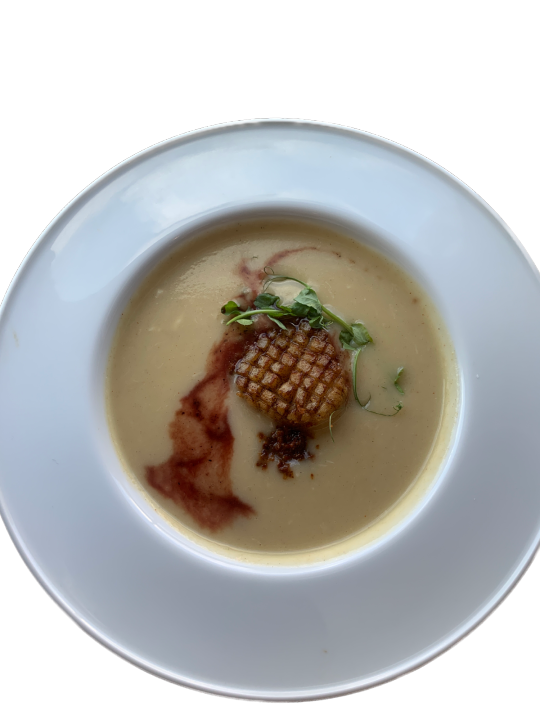
Appetizer 2: Spiced Ostrich Steak Salad with Brandy Glaze
Taste- umami, sour, bitter from greens and char, sweet fruit
Flavor- meat like steak, rice vinegar, pomegranate, greens, chickory, carrot
Texture- med rare steak, spinach texture, smooth and sour from vinaigrette, warm carrot knots
Appearance- pea tendrils garnish purplish meat and carrot knots and pomegranate seeds for nearly full rainbow of color (no blue)

Entrée: Venison Denver Steak, roasted beets, root vegetable mash, braised shallots, Red Wine Demi
Taste- umami, salt sweet
Flavor- chocolate, carrot, root veg earthiness game meat toasted beets, thyme
Texture- medium rare meat, chew. Soft puree warm cooked beets
Appearance- circular presentation with denver half cut in center, toadstools surround made of puree with beet cap, ring of sauce connecting garnish thyme sprigs

Part 2 Evaluation of Techniques
Technical Outcomes
Techniques that Worked Well- Chowder technique worked well. The chowder was very smooth and thick. Searing the scallop worked well and I got some more practice with that. The fish in the chowder was tender and not overcooked.
Techniques that Did Not Work Well- The root vegetable mash was not as well done as I would have liked, but it tasted fine. The texture did not look smooth and it was leeching moisture. I wish that the glaze would have tasted better for the denver. The glaze for the ostrich went all wrong and was unbelievably salty and burnt.
Assessment of Plate Presentations
The presentations all looked pretty good this week with not many variations ont he chowder. Some of the salads had cooked greens which did not look fresh. The portions for some were rather generous but some were dialed back and better for an appetizer.
Improvements/Changes
In the future I would smooth the puree more. I would use less chocolate for the red wine reduction and I would not add any salty components to the glaze until the very end and keep it from burning. I liked my ostrich presentation the best out of mine and I would like to continue using many colors in presentations. I liked the chowder the least because I wished the color was lighter on the chowder and the texture was thinner.
Part 3 Sustainability
Integration of Practice: In the procurement part of the food chain, we made sure that our game meat was coming from a legal source. We used scallops from the weeks previous to reduce food waste. We used vegetable scraps in the fish stock as well.
America’s top 5 wild game meats

Image Link: https://www.americanhunter.org/content/america-s-top-5-wild-game-meats/
Impact on Overall Sustainability: Legally acquiring game meat is important to protect public health, as illegal harvesting can bypass safety regulations, leading to contaminated or unsafe food. It also helps sustain ecosystems by preventing overharvesting and ensuring species populations remain balanced.
Personal Performance: I am currently looking into how to get my place of work to start recycling glass. Something good from in the lab is how we all share ingredients with each other instead of breaking into a new one.
Areas for Improvement: We worked this week on communicating better within our group and delegating tasks. This worked better for me because I was doing a lot less work than usual. I could intervene more when I see things going wrong to waste less time and food.
Part 4 Conclusions
Outcomes: We demonstrated the advanced soup making technique of chowder. We explored the unique flavors and textures of ostrich and venison. We applied precise cooking methods for game meats, such as grilling and pan-searing ostrich steak and properly cooking venison Denver steak to the desired doneness, ensuring tenderness and juiciness, and we produced a refined pan sauce.
Objectives: We met the objectives that were to demonstrate the chowder technique, explore the unique flavors and textures of ostrich and venison, apply precise cooking methods for game meats ensuring tenderness and juiciness, and to produce a refined pan sauce.
Additional: I learned about cooking ostrich and its interesting similarity to beef. I would love to learn more about why they taste so similar to me. I also learned about some of the properties of carrots and that they can be tied in knots.
Practice: I want to work on being able to effectively lead my team in a way that is gentle, respectful, and for the benefit of all of our learning. I want to work on controlling my own personality and gently responding to comments that I deem unnecessary to the task at hand in order to be a friendlier leader.
Recipes and Plan of Work
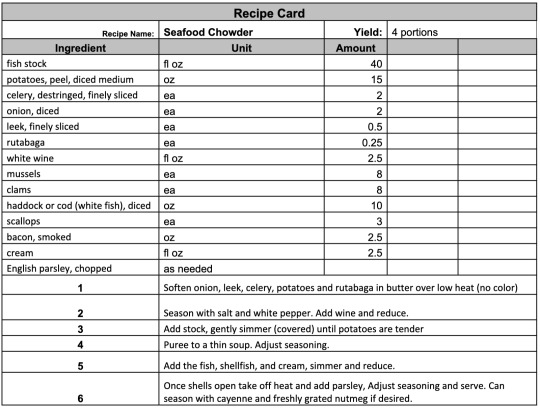






Plan of Work
1-115 demo talks
120 start ostrich glaze, takes 30-40 minutes
Meanwhile make ostrich rub (chicory)
2pm ostrich glaze is done
3-315 reduce chowder with seafood in. low simmer ot be gentle with protein
315 start plating for both apps
330 plate chowder and plate ostrich salad
Let denver get thawed
Roast beets 350F, make root veg mash takes 20 min
Salt and pepper on rack to dry
410 pm Pan with thyme juniper berries butter and oil , baste, temp 125-130
430 denver steak
445 cleanup
0 notes
Text
Research: Game Meat II (Furred) and Ostrich
Week 8
MENU
Appetizer 1: Seafood Chowder Appetizer 2: Spiced Ostrich Steak Salad with Brandy Glaze Entrée: Venison Denver Steak, roasted beets, root vegetable mash, braised shallots, Red Wine Demi
Part 1 Introductions
Method of cooking/technique to discuss:
Chowder
Learning Objectives:
Demonstrate advanced soup making techniques: chowder.
Explore the unique flavors and textures of ostrich and venison
Apply precise cooking methods for game meats, such as grilling and pan-searing ostrich steak and properly cooking venison Denver steak to the desired doneness, ensuring tenderness and juiciness.
Produce a refined pan sauce.
Prior Knowledge:
Primary Ingredient of the week:
Venison and Ostrich
I have had white tail deer venison from neighbors and friends. The individual hunters will butcher it the way they choose; oftentimes people like to make venison sausage and burgers.
I have seen ostrich eggs and they are huge, I have not had ostrich meat. I just hope it is ethically sourced.
Part 2 Background Information
Method: Chowder
“Chowder is a hearty, thickened soup that has been a staple in coastal cuisine for centuries, traditionally made with seafood but also available in various regional variations featuring different ingredients.
Chowder is rich, creamy base, typically made from milk or cream, thickened with flour or potatoes, and infused with seafood or other hearty ingredients. Ingredients like onions, celery, and potatoes form the foundational aromatics, while proteins such as fish, shellfish, or even chicken add depth and substance.
Seafood chowder often features clams, shrimp, mussels, or fish, providing a briny, fresh flavor that contrasts beautifully with the creamy broth. It’s important to control the heat to avoid overcooking the seafood or curdling the cream. Seafood should be added toward the end of cooking to maintain its tenderness. The starch from potatoes or the addition of a roux helps thicken the chowder, giving it a velvety texture without being too heavy.
Garnishes such as herbs, bacon, or fresh seafood elevate the presentation and add another layer of flavor.”
Primary Ingredient: Venison
“Venison, the meat from deer, elk, moose, or caribou. It is prized for its rich, earthy flavor, lean texture, and slightly sweet taste that distinguishes it from more commonly consumed proteins like beef or lamb.
One of the key challenges in cooking venison is its low fat content, which can make the meat prone to drying out if overcooked. To preserve moisture and enhance tenderness, venison is often cooked using methods such as fast high heat cooking techniques such as searing, roasting, or slow braising.”
Primary Ingredient: Ostrich
“Ostrich is gaining popularity in professional gourmet kitchens due to its unique flavor and health benefits. Ostrich meat resembles red meat like beef in both texture and taste. It has a mild, slightly sweet flavor and is incredibly lean. Cooking with ostrich requires careful attention due to its low fat content, which can cause the meat to dry out if overcooked. Ostrich is best prepared using quick, high-heat methods such as grilling, pan-searing, or broiling to achieve a perfect medium-rare doneness. This helps retain its moisture while keeping the meat tender and juicy. Marinating or basting can also add extra moisture and flavor.
Ostrich pairs well with bold seasonings like garlic, pepper, and spices, and it complements sauces made with red wine, balsamic, or fruit reductions like berry or citrus compotes. Because of its versatility, ostrich can be used in steaks, burgers, or even in salads and lighter dishes. Its lean, game-like quality makes it an exciting ingredient for chefs looking to expand their repertoire with more exotic proteins.”
Part 3 Recipe R&D
Provided Recipes:
Part 4 Recipes
Provided Recipes:
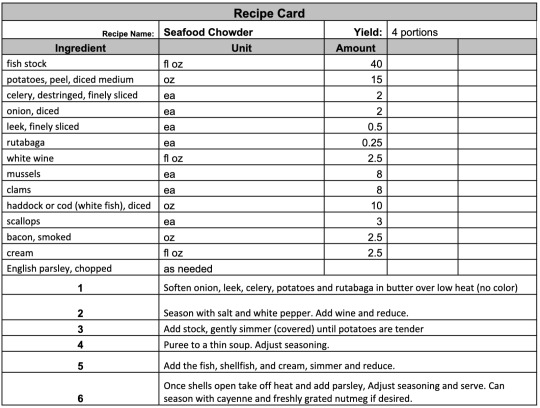





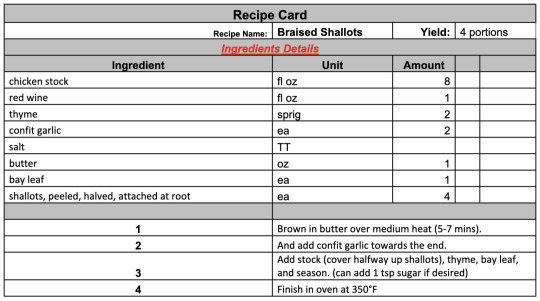
Plan of Work
0 notes
Text
Research: Furred Game
Week 7
MENU
Amuse Bouche: Smoked Scallop on Pane Carasau with Green Harissa, Crème Fraiche, Smoked Trout Roe Appetizer: Rabbit tortellini consommé Entrée: Duck Lasagne, carrot puree, carrot top salsa verde, and carrot salad
Part 1 Introductions
Method of cooking/technique to discuss:
Tortellini and Smoking
Learning Objectives:
Demonstrate proper cold-smoking techniques.
Prepare fresh tortellini from scratch - making a pasta dough (egg pasta) and shaping tortellini.
Execute a clear consommé.
Prior Knowledge:
Primary Ingredient of the week:
Rabbit and Fresh Pasta (egg pasta)
Part 2 Background Information
Method:
Tortellini- To make tortellini, you need a rolling pin or pasta machine to roll out the dough thinly, a sharp knife or pasta cutter to cut the dough into squares or circles, and a small spoon for adding the filling. You may also use a fork to seal the edges, though some people prefer doing it by hand. A slotted spoon is helpful for removing the tortellini from boiling water once they're cooked.
Evangelists, A. P. (2020b, March 9). A simple guide to making homemade Tortellini. Pasta Evangelists. https://pastaevangelists.com/blogs/blog/how-to-make-tortellini
Smoking- We will be infusing a smoky aroma into raw scallops without cooking them, adding complexity to an amuse bouche that pairs smoky scallops with crème fraiche, green harissa, and caviar.
A smoking gun enhances food by adding a smoky flavor without the need for traditional smoking methods. It uses cold smoke, which infuses foods like meats, cheeses, and cocktails with a rich, aromatic taste. The process is quick and can be done after cooking, allowing more control over the intensity of the smoke. This tool is versatile, bringing depth and complexity to a wide range of dishes.
Primary Ingredient:
Rabbit- Rabbits are mammals, they like to live in groups and dig tunnels under the ground to protect themselves. They are herbivores and they are a prey species with many predators.

Below is a diagram of the cuts from rabbit and a high quality video on fabricating a rabbit carcass.

Video Link: https://youtu.be/HVEX0b61dKU?t=450
Fresh Pasta- Proper rolling, filling, and sealing of the pasta are critical to achieving uniform, well-cooked tortellini that hold their shape and enhance the flavor of the rabbit filling. We were introduced to fresh pasta making a few weeks ago in laboratory, for this week we will be making fresh egg pasta.
Part 3 Recipe R&D
This week, all of the recipes are provided.
Provided Recipes:
Amuse Bouche: Smoked Scallop on Pane Carasau with Green Harissa, Crème Fraiche, Smoked Trout Roe

Pane Carasau is a Sardinian bread that looks like this.
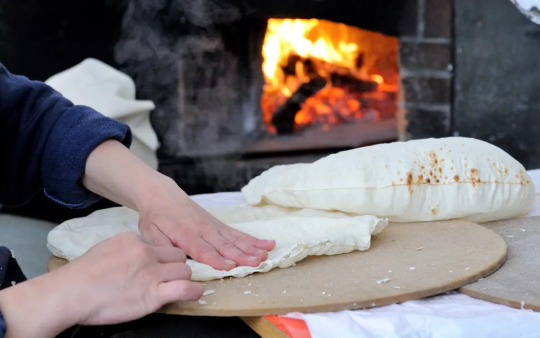
Appetizer: Rabbit tortellini consommé
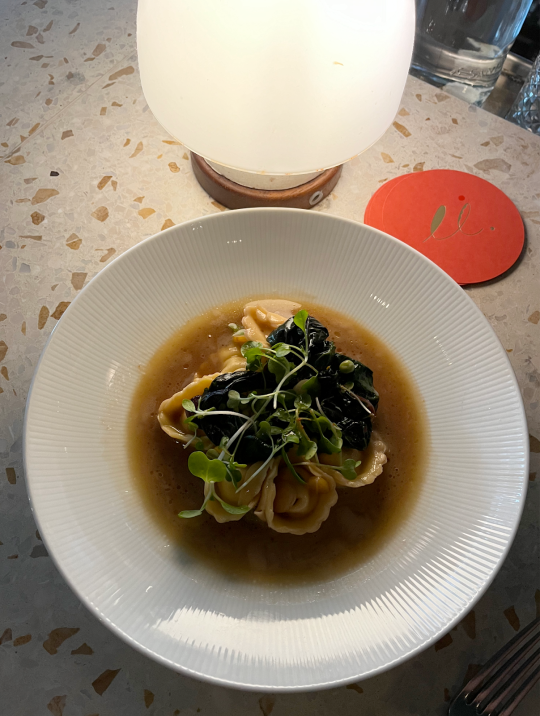
Entrée: Duck Lasagne, carrot puree, carrot top salsa verde, and carrot salad

Part 4 Recipes
Provided Recipes:





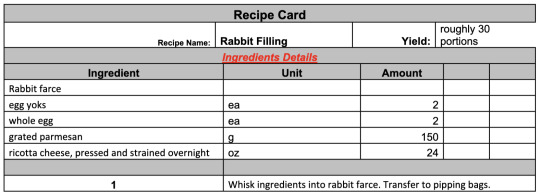
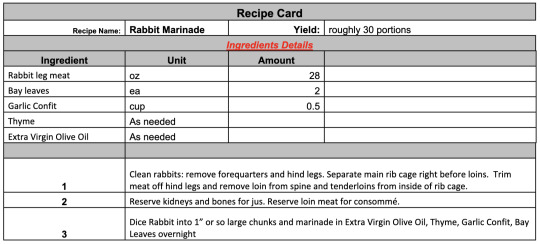





Plan of Work
1-125 talk and demos?
Smoked Scallop
125 make pasta dough, let rest 30 min
130 make Green Harissa, one batch per lab class, gather Pane Carasau, Crème Fraiche, Smoked Trout Roe
140 Smoke and chill the scallop. Fruit woods apple or cherry
150 Plate Amuse
2 pm consomme. Takes an hour of low simmering undisturbed
2:15 toast and grind peppercorns. rabbit farce. The rabbit is marinated and rabbit stock is made
220 grate parmesan. rabbit filling
duck ragu? Get it cooking
Carrot top salsa verde let it combine
230 roll pasta dough, cut, shape tortellini
3:15 Plate App Rabbit tortellini consommé
315-330 big cleanup
3:30 Cocoa bechamel, takes 20 minutes
3:50 assemble
4pm Bake lasagna 30 min?
Deep Fry lasagna ?
405 carrot puree
410 carrot salad
4:40 Plate Entree
5 cleanup
0 notes
Text
Research: Feathered Game
Week 6
MENU
Amuse Bouche: Sous Vide Duck Breast, Pear Chutney, Bitter Lettuces (Frisee, Chicory, Endive). Appetizer: Root Vegetable Boudin Stuffed Quail, Spiced Blackberry Compote. Entrée: Roast Pheasant, Quail Egg, Succotash and Gastrique
Part 1 Introductions
Method of cooking/technique to discuss:
Sous Vide
Learning Objectives:
Identify and Distinguish Game Birds: identify the characteristics of quail, pheasant, and duck, understanding their unique flavors, textures, and cooking requirements.
Apply Proper Butchery Techniques: demonstrate proper butchery techniques for game birds, ensuring minimal waste and optimal presentation.
Master Cooking Techniques for Game Birds: skillfully execute a variety of cooking methods such as roasting, pan-searing, and braising to cook quail, pheasant, and duck to perfection.
Balance Flavors and Accompaniments: pair game birds with appropriate sauces, seasonings, and side dishes, showcasing an understanding of flavor profiles and complementary ingredients.
Critique and Reflect on Cooking Outcomes: critically evaluate your own and peers' dishes, providing feedback on flavor, texture, presentation, and cooking technique while reflecting on areas for improvement.
Create Advanced Sauces (Compote and Gastrique): prepare and apply advanced sauces, such as fruit compotes and gastriques, to complement the flavors of game birds, demonstrating an understanding of balancing sweetness, acidity, and texture in sauce making.
Cook Duck Breast Using Sous Vide Techniques: expertly cook duck breast using sous vide methods, controlling temperature and time to achieve precise doneness, tenderness, and optimal flavor retention.
Prior Knowledge:
Primary Ingredient of the week:
Duck, Quail, and Pheasant
I know a bit about duck from Chef Joel Antunes’ menu this past month. The duck was sous vide and then stored, then seared on the flat top on both sides with the skin presented on top. It was served with gnocchi romaine and a rosemary caramelized fig. The duck (only the meat, not the skin so that it remains crisp) was covered with an asian inspired orange coriander sauce. From what we talked about in class, duck pairs well with orange, coriander, rosemary and asian flavors, just as chef Joel paired it.
Quail is not something I have prepared. I have seen quail eggs in the grocery store, but not the animal itself. Here is a picture from a movie, Corpse Bride, in which I believe the dinner guests are somberly eating roasted quail.
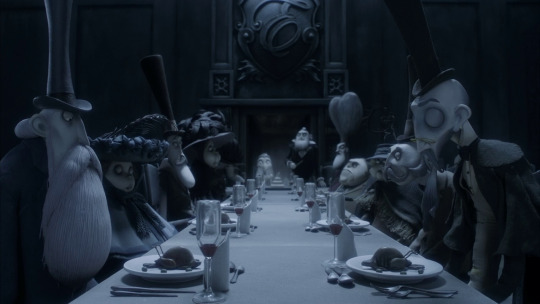
Pheasant is the most popular game bird, it is larger than quail. I do not know much about pheasant at all. I imagine it tastes a bit like chicken.
Part 2 Background Information
Method:
Primary Ingredient:
Part 3 Recipe R&D
Chosen Recipes:
Finishing duck breast (searing)-
Pear Chutney-
Bitter Lettuces (Frisee, Chicory, Endive)-
Spiced Blackberry Compote-
Pheasant- marinate or brine, then roast. Pull at 150°F (desired temp 155°F), 1 whole pheasant per group, split whole bird in half.

Provided Recipes:
Sous Vide Duck-
Root Vegetable Boudin Stuffed Quail- cook 150°F (desired temp 155°F), 2 whole quail per group
Succotash-
Braised Duck Leg-All duck legs will be braised in one pan to be used in Module 7
Part 4 Recipes
Chosen Recipes:
Finishing duck breast (searing)- sear on flat top with oil skin side down, finish in oven at 515F (!?) for 9 minutes.

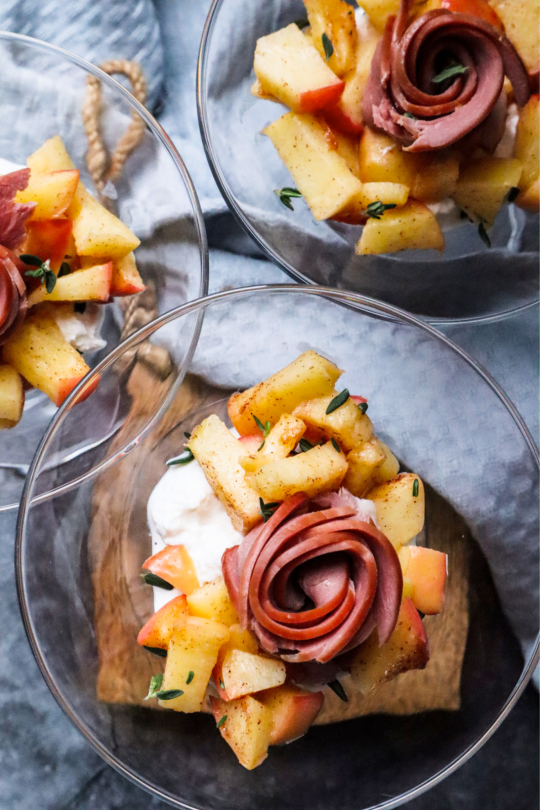
Pear Chutney-

Bitter Lettuces (Frisee, Chicory, Endive)-

Spiced Blackberry Compote-
300gr of frozen mixed berries – like raspberries, blackberries and blueberries
The juice + the zest of 1 orange
1/4 cup of maple syrup
1/2 tsp of cinnamon powder
Pheasant- marinate or brine, then roast. Pull at 150°F (desired temp 155°F), 1 whole pheasant per group, split whole bird in half.


Gastrique- (with quailegg pheasant and succotash)
2 parts sugar, 1 part vinegar. Consult the pairing pheasant list for fruit ideas. Use onion for sweet and savory
Provided Recipes:
Sous Vide Duck-

Root Vegetable Boudin Stuffed Quail- cook 150°F (desired temp 155°F), 2 whole quail per group
marinate it in a little olive oil and orange juice with a few slices of fresh ginger and maybe some fresh thyme.
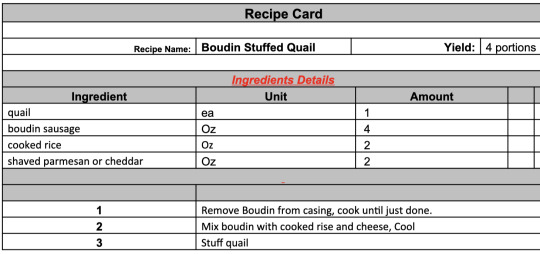
Truss the quail. Coat with lard/butter, roast in oven 500F or hotter, 12-18 minutes until temp reads 150F
Succotash-

shakshukotash

Braised Duck Leg-All duck legs will be braised in one pan to be used in Module 7

Plan of Work
1-115 demos/discussion
Break down duck and sous vide immediately, 80 minutes. 130F the breasts will be cooked sous vide, the legs will be braised and stored for the following week's class, and the carcass will be used for stock
125 sous vide duck by this time
Pear Chutney on, spiced blackberry Compote, Boudin stuffing, pheasant Gastrique
245 sear duck
3-315-plate up amuse (duck, pear chutney, frisee)
345-4 plate up app (stuffed quail, blackberry comp)
4-415 huge cleanup
445 plate up entree
5 clean up 530 final debriefs
0 notes
Text
Reflection: Shellfish
Week 5
MENU
Amuse Bouche: Oysters with mignonette and cocktail sauce, Odd Groups: Baked Oysters, Even Groups: Grilled Oysters Appetizer: Sauteed Mussels, Mussels Mariniere Entrée: Linguine alle Vongole
Part 1 Sensory Results
Amuse Bouche 1- Oysters with mignonette and cocktail sauce, Raw
Taste- The taste was mild and salty
Flavor- ocean water, slightly meaty, lemon. mignonette added onion and vinegar
Texture- chewy squishy. Just swallow it don't chew
Appearance- raw oysters surrounding a bowl of mignonette and lemon

Amuse Bouche 2- Oysters with mignonette and cocktail sauce, Baked
Taste- salt, umami, bitter, sour
Flavor- much more flavorful than raw, salty ocean but also cheesy parmesan and bready flavor, parsley and herbs
Texture- much better than raw, cooked and more tender bite, drier crispy, cheese pull and breadcrumbs
Appearance- 6 grilled oysters with browned toppings, parmesan and breadcrumbs

Appetizer-Sauteed Mussels
Taste- salty, sweet, sour some umami
Flavor- soft and sweet flavor, buttery, white wine, thyme, seafood.
Texture- saucy, aroma of wine, butter and ocean. Chewy small bites, crunchy bread
Appearance- yellow meat of mussels in dark shells. Looks like a lot more food than it is due to shells. Grilled bread and thyme sprigs to suggest flavors

Entree- Linguine alle Vongole
Taste- carby, bland, salt fat sour
Flavor- seafood, lemon, parsley, white wine, garlic, red pepper
Texture- very dry pasta, needed to be oiled/buttered before served
Appearance- large pasta twirl garnishes with preserved lemon skin and parsley. Opened clams (6) surround the pasta. Everyone’s presentations looked like this

Part 2 Evaluation of Techniques
Technical Outcomes
Techniques that Worked Well- Sauteing mussels worked well. I thought this dish turned out the best for us out of the ones this week. The flavors were harmonious and I could see myself enjoying this appetizer. The bread was essential because it allowed you to eat the mussel flavored juice/broth.
The oyster shucking method became easier as I did more. I could tell the difference between a good oyster and a dry oyster based on the sound.
Technique that worked fairly well- Grilling the oysters took a while, but it eventually resulted in a good product. If we had a hotter grill or charcoal grill with a lid that allowed it to close and build up heat and smoke flavor that would have been the best. I would try this again with a charcoal grill and some more spicy flavors.
Techniques that Did Not Work Well- The Linguine alle Vongole was the worst dish I have made in this lab. Basically everything went wrong, the pasta was too sticky and clumped together, the pasta was too salty, the clams were not steamed properly so they cooked too long and shrank to nothing. The presentation had too much pasta and basically no clam meat, just huge shells. I would have been irate if I received this from a restaurant.
Assessment of Plate Presentations
None of our presentations looked very good to me. For the oysters, we were running behind and so we received help from other groups. I wanted a big bed of rock salt which we did not have and I did not have time to plate it myself as I was grilling the oysters so the presentation was just a line of salt with some oysters on top which I thought made no sense.
In comparison with the other presentations, I saw a lot of similarities. I think everyone felt that there was one direction to go with this and since it was a more technical lab, there was less experimentation with plating and creative choices.
Improvements/Changes
In the future I would use a charcoal grill for the oysters, I would cook the pasta in more water and less salted water and strain and rinse with water and toss with butter or oil before heating with the clams. I would use more steam for the clams. I will know better what to look for regarding done-ness now and I imagine things would turn out better if I tried again.
Part 3 Sustainability
Integration of Practice: In the procurement part of the food chain, we made sure of where our seafood came from and that it was from a legal source. We used wine which uses a lot of water to produce, but we avoided using red meat.

The image above shows litres of water per kg of food for various types of food, with bovine meat consuming the most and vegetables consuming the least. The data is taken from world averages.
Image Link: https://www.weforum.org/agenda/2021/06/water-footprint-food-sustainability/
Impact on Overall Sustainability: Legally acquiring shellfish is important to protect public health, as illegal harvesting can bypass safety regulations, leading to contaminated or unsafe food. It also helps sustain marine ecosystems by preventing overharvesting and ensuring species populations remain balanced.
Personal Performance: I am currently looking into how to get my place of work to start composting. Something good from in the lab is how we all share ingredients with each other instead of breaking into a new one.
Areas for Improvement: We did not use the best judgment when cooking the clams which resulted in overcooking them. I want to work on budgeting time well enough that we can slowly taste test these recipes we are unfamiliar with. In a restaurant setting, this simple mistake would cost a lot of time and resources and can be easily prevented by being more careful and not being rushed by other things that need to happen.
Part 4 Conclusions
Outcomes: We gained understanding on the fundamental principles of oyster preparation, we learned the key techniques and safety guidelines for selecting, shucking, and preparing oysters. We compared oyster preparation methods and analyzed various oyster preparation methods, including raw, grilled, and baked approaches. We prepared a sautéed mussels dish, we created fresh pasta from scratch, we cooked clams using appropriate techniques, and we evaluated a variety of shellfish dishes.
Objectives: We met the objectives that were to understand the fundamental principles of oyster preparation including the key techniques and safety guidelines for selecting, shucking, and preparing oysters. We compared oyster preparation methods and analyzed various oyster preparation methods, including raw, grilled, and baked approaches. We prepared a sautéed mussels dish, we created fresh pasta from scratch, we cooked clams using appropriate techniques, and we evaluated a variety of shellfish dishes.
Additional: I learned about the importance of steam in opening shellfish and how it is important to use the correct knife for shucking. I learned the difference between the shellfish including how they are grown and how they are harvested.
Practice: I want to work on being able to modify as we go, according to the needs and capabilities of my teammates. We were forced to greatly simplify the menu this week due to one person being absent, and it resulted in a decrease in quality compared to other weeks. If we are down a groupmate again, I would like to be able to adapt and still complete a satisfactory menu.
Recipes and Plan of Work







0 notes
Text
Research: Shellfish
Week 5
MENU
Amuse Bouche: Oysters with mignonette and cocktail sauce, Odd Groups: Baked Oysters, Even Groups: Grilled Oysters Appetizer: Sauteed Mussels, Mussels Mariniere Entrée: Linguine alle Vongole
Part 1 Introductions
Method of cooking/technique to discuss:
Sauteing mussels, baking and grilling shellfish
Learning Objectives:
Explain the Fundamental Principles of Oyster Preparation: explain the key techniques and safety guidelines for selecting, shucking, and preparing oysters.
Compare and Contrast Oyster Preparation Methods: analyze and differentiate between various oyster preparation methods, including raw, grilled, and baked approaches.
Prepare a Sautéed Mussels Dish: skillfully prepare and present a sautéed mussels dish, demonstrating mastery of flavor balancing and cooking techniques.
Create Fresh Pasta from Scratch: produce fresh pasta, showcasing appropriate cooking methods.
Cook Clams Using Appropriate Techniques: effectively cook clams to enhance flavor and texture.
Evaluate a Variety of Shellfish Dishes: critically assess different shellfish dishes based on taste, texture, presentation, and the techniques used in their preparation.
Prior Knowledge:
Primary Ingredient of the week:
Oysters, Mussels, Clams
I know almost nothing about any of these creatures. I get them at the Korean hot pot restaurant and I do not know what part to eat I just like how it flavors the broth. The part that I have chewed on has been really rubbery. I am pretty sure that you should not eat the ones with the shells coming open on their own because that means they are dead or going bad. I am ready to know more about this intimidating food.
Part 2 Background Information
Method:
Sauteeing Mussels- Heating a pan with oil and adding the mussels directly happens first, then all of the other ingredients are added in rapid succession. The high heat cooks the mussels in a couple minutes. Once theye begin to open the juices leave the mussels and create liquid that the other ingredients cook in.

Image: https://chefsilvia.com/sauteed-mussels/
Baking and Grilling Shellfish- From Grillaholics, a trusted source, based on the name, “Grilling these bad boys is super easy. Get your grill super hot, and then you can put your shellfish right on the grate. Close the lid, and wait! No need to turn them or touch them. Mussels and clams will both take between five and ten minutes to cook. When they begin to open up, they’re ready to eat. If you have any clams or mussels that don’t open, discard them -- they’re not safe to eat.”
Another suggestion was to shuck them and add a sauce before grilling. Simply Recipes offers advice if you choose not to shuck.

Image: https://www.nola.com/entertainment_life/eat-drink/how-to-grill-oysters-at-home-new-orleans-chefs-expert-tips-recipes/article_0b9b7a36-97aa-5402-a79f-3278a32db8a5.html
“If you can't shuck: Place the oysters, cup side up on a very hot, preheated grill, cover and cook for 1 minute. The oysters should now be slightly open. Quickly remove the oysters. Use a shucking knife to pry open the oyster. It should easily open. Spoon sauce into each oyster and return oysters to the grill. Cover and grill 4-5 minutes.”
Hair, J. (2024, April 18). Grilled oysters are a fast and fancy addition to your next cookout. Simply Recipes. https://www.simplyrecipes.com/recipes/grilled_oysters/
Primary Ingredient:
Image Link: https://www.thekitchn.com/the-9-most-popular-types-of-shellfish-23489141
Oysters- From TheKitchn, “Oysters are the bivalve that’s most frequently eaten raw. With their craggy shells and succulent, briny meat, oysters get their flavor from the salt water they grow in. American oysters can be found all along the East and West coasts, most commonly in the Pacific Northwest and the Northeast. However, oysters also thrive in the Chesapeake Bay region, the Gulf Coast, and the Bay Area of California.
Oysters don’t need much to make them shine: Once they’re shucked, lemon wedges, mignonette, or cocktail sauce are traditional accompaniments. Or make throwback oysters Rockefeller.”
The map below shows where oyster harvesting is allowed or prohibited in the state of Alabama.

The key Differences Between West Coast and East Coast Oysters are listed below:

Image Link: https://www.outdooralabama.com/sites/default/files/fishing/Saltwater/Regulation%20PDFs/Regulation%20Images/Oyster_Managament_Station_Zones%20and%20ADPH%20Zones.jpg
Mussels- To learn about mussels, the next type of shellfish we will be preparing, TheKitchn explains, “Mussels are another variety of bivalve mollusk. Marine blue mussels, which attach to rocks and other surfaces in the intertidal shallow areas along saltwater coastlines, are the ones with a shiny black oval shell and a very soft and sweet inner edible muscle.”
Where are mussels found? TheKitchn says, “Like many shellfish, mussels are found around the world, with two of the most popular growing regions being Prince Edward Island in the North Atlantic and the Pacific Northwest waters around Washington and British Columbia. Although they can be harvested wild, farmed mussels are becoming increasingly popular.”

Mussels are commercially grown on ropes or posts as you can see here. This makes harvesting much easier and the growing area more compact. This is a way of raising and harvesting that is becoming more prevalent.
Clams- From what was shared in the classroom post, “Clams are bivalve shellfish with a briny, slightly sweet flavor and a tender, chewy texture. The most common varieties include littleneck, cherrystone, and Manila clams, each varying slightly in size and taste. Live clams should have tightly closed shells or close quickly when tapped. Any that remain open should be discarded. Cleaning clams properly before cooking is important, as they often contain sand, which can be removed by soaking them in salted water for a few hours to encourage them to expel grit.”

Image:https://www.allrecipes.com/recipe/12737/scott-ures-clams-and-garlic/
Part 3 Recipe R&D
Chosen Recipes:
Grilled oysters- The recipe I found, well I found two, the one that I would like to use is a New Orleans style oyster. There is a lot of butter, and a crust that forms from the parmesan and breadcrumbs.
Plate presentation below.

Image: https://adventuresincooking.com/grilled-oysters-on-half-shell-with/
sauteed mussels- The sauteed mussels were hard to figure out because most want you to steam where the definition of saute is to use a hot fat/oil to cook with. I have one recipe that boils in a saute pan.
Provided Recipes:
cocktail sauce- From Wikipedia, “The standard ingredients (in roughly decreasing proportion) are ketchup, horseradish, hot sauce (e.g., Tabasco, Louisiana, or Crystal), Worcestershire sauce, and lemon juice. A soufflé cup is usually set in the middle of the platter of oysters along with a cocktail fork and a lemon slice.”
Migonette sauce- Mignonette sauce is a condiment made from vinegar, minced shallots, and pepper and served with raw oysters and clams.
Mussels Mariniere- According to Red Crab, “Moules mariniere has a delicate, briny flavor with hints of garlic, shallots, and wine. It's both savory and slightly sweet from the fresh mussels.” “A seafood classic. Simply warm the sauce, add mussels, cover and simmer for 5-10 minutes. Serve with fries or crusty bread,” says the fish society.

Linguine alle Vongole- “It's what's known as an al minuto sauce, meaning it comes together in just a few minutes. You only need six ingredients, in addition to the pasta, to make authentic Linguine alle Vongole: Olive oil, garlic, red pepper flakes, parsley, fresh clams, and white wine,” says the Mediterranean Dish.
Part 4 Recipes
Chosen Recipes:
Grilled oysters
Classic Grilled Oysters
Makes sauce for 2 dozen oysters
1/2 pound butter
6 garlic cloves, rasped
1 teaspoon hot sauce (Prescott prefers Pop's Midnight Heat From Cajun Country)
1/4 teaspoon smoked paprika
1/4 teaspoon Worcestershire
1/4 cup chopped fresh parsley
Salt, to taste
Pepper, to taste
1-1/2 cup unseasoned bread crumbs
1/2 cup Italian seasoned bread crumbs
1 cup freshly grated parmesan cheese
Combine the first five ingredients and cook over low heat just until the butter is melted. Wait 5 minutes, then add parsley, salt and pepper.
In a bowl, mix together the two types of bread crumbs.
Open oysters, leaving them on the half-shell. Do not cut oysters loose from the shell.
Place oysters on a very hot grill (500 degrees or more, if possible). Ladle approximately a tablespoon of butter sauce on shucked oyster. Oysters come in lots of different shapes and sizes, so add more or less as needed.
Sprinkle the breadcrumb mix and parmesan over sauce. Allow to cook until the excess oyster juice has evaporated and the cheese and bread crumbs begin to brown on the edges.

Hair, J. (2024, April 18). Grilled oysters are a fast and fancy addition to your next cookout. Simply Recipes. https://www.simplyrecipes.com/recipes/grilled_oysters/
sauteed mussels, two options


Provided Recipes:
cocktail sauce

Migonette sauce

Mussels Mariniere
Linguine alle Vongole
Plan of Work
Ingredients needed: breadcrumbs, parmesan, dijon mustard, dry white wine, saffron?, parsley
1-120 demonstration
120 migonette and cocktail sauce,
oysters, thin long knife for ruffled west coast, shorter bent tip for smoother east coast
Shuck them, make the butter sauce, grill them and add sauce.
Serve all on a plate on some rock salt
plate up ???
150 clean scrape barnacles remove beards and soak mussels in fresh water
200 scrub and soak clams in salt water, refrigerate
245 cook the mussels and plate for 3pm presentation
3-3-15 sample Sauteed Mussels, Mussels Mariniere demostration
315 make pasta on the extruder
4pm clams done soaking
415 proceed with vongole recipe4:30 Linguine alle Vongole
0 notes
Text
Reflection: Plant Based
Week 4
MENU
Amuse Bouche: Seared King Trumpet Mushrooms, Parsnip & Onion Soubise, Parsnip Crisp Appetizer: Butternut Squash Bisque Entrée: 1. Riced Cauliflower, Caramelized Butternut Squash Steak or 2. Roasted Cauliflower Steak, Butternut Squash Puree, pickles
Part 1 Sensory Results
Amuse Bouche
King Trumpet Mushroom Scallop
Taste- the tastes were all quite mild. Savory. Some bitter taste from the earthiness of the mushroom. Soubise sweet and light, savory parsnip crisps salty and filling
Flavor- there was a slight seafood flavor due to the seaweed marinade. The soubise was smoky, oniony. The parsnip flavor added a greener flavor to the expected starchiness from a fried root such as potato
Texture- the mushroom texture was chewy and had fibers that mimicked the muscle fibers of a scallop. The soubise was very light and smooth. The parsnip crisps were crunchy and fatty like chips
Appearance-

Curried Butternut Squash Bisque
Taste- Sweet, creamy, salt savory, accidentally bitter astringent from the flower petals. Always taste the flower before garnishing!
Flavor- I enjoyed the curry flavors and the sweetness from the squash and maple syrup. There was a warmth from the vadouvan curry spices
Texture- the texture was very smooth, the mouthfeel was thicker and more aerated than cream. It was smooth like butter
Appearance- We tinted the coconut milk with some of the bisque so that the swirl would have the same hue as the soup. Garnished with toasted pumpkin seeds and rooftop petals

Cauliflower Steak
Taste- salty, sweet. Some savory and sour/bitter. Puree overly sweet
Flavor- cauliflower, butternut squash, maple syrup, lemon. Least interesting of flavors from the dishes in class today
Texture- the tender ends were cooked through and toasted, the stalk was undercooked and needed to be softer
Appearance- base of b.sq. puree, pan seared cauliflower steak seared decently well, toasted sprouted mung beans, rooftop flowers

Part 2 Evaluation of Techniques
Technical Outcomes
Techniques that Worked Well
We did not use the original French bisque technique as we were doing a plant based menu. There was no seafood with which to use the shells of. We also did not create a flour roux, we instead thickened with coconut milk and squash puree. The bisque technique worked well for the curried butternut squash. The final strain that we did helped to smooth it out even further. The technique worked well to create a smooth bisque.
Alfaro, D. (2023, January 19). Bisque is more than a thick, creamy soup. The Spruce Eats. https://www.thespruceeats.com/what-is-bisque-995579
The vegetables puree technique worked well, the issue was that the ratio of tastes was too sweet for a savory menu item. It would have been better in a dessert.
Techniques that Did Not Work Well
The cauliflower steak did not turn out great. The flavors were not very complex and the stalk was undercooked. Next time I would either cut the stalk thinner or boil the veggie for longer before searing. I think the ends would have survived a longer boil.
Kitchen, F. N. (2023, January 31). What is blanching? https://www.foodnetwork.com/how-to/packages/food-network-essentials/what-is-blanching
Assessment of Plate Presentations
I like how the amuse turned out. I was able to execute it according to my plate presentation drawing and I am pleased with the neat presentation with the one spoon. We have been trying to plate the amuse in a way that is eye-catching and still only one or two bites. The surface landscape of the bisque was shiny and a pretty yellow ochre color. Garnishes added accents of burnt sienna and tiny pieces of green from the connections on the petals. The cauliflower steak adhered to the plate presentation in terms of arrangement, however the searing and colors were not as I had hoped. I was hoping for a warmer and more vibrant golden-brown for the cauliflower steak as well as a more intense and even sear.
In comparison with the other presentations, I see other groups chose to use the scallop presentation. Their sears were not as spread out as ours, and from watching them I think the difference was that we marinated our “scallops” in a brine before searing which added more juice and volume to the finished product. See image below to the seared scallops.

Improvements/Changes
In the future I would choose a different puree recipe with more complex flavors, I would minimize the size of the cauliflower steak presentation. I would check the flavor of the garnishes before plating.
Part 3 Sustainability
Integration of Practice: In the production part of the food chain, we eliminated the use of a lot of water and energy since we used no animal products. In our lab we reduced production of waste. The recipes worked together to ensure that the scraps were used in the meals to the greatest extent possible; the cauliflower scraps from the steak were used for riced cauliflower and the butternut steak scraps were used for puree.

The image above shows litres of water per kg of food for various types of food, with bovine meat consuming the most and vegetables consuming the least. The data is taken from world averages.
Image Link: https://www.weforum.org/agenda/2021/06/water-footprint-food-sustainability/
Impact on Overall Sustainability: This week was a great example of sustainable choices. We used an almost entirely vegan menu this week, the one exception was one of the ingredients had butter and that went in accidentally. The lack of use of animal products is a great way to eliminate excessive water and energy usage from raising animals.
Personal Performance: I am currently looking into how to get my place of work to start composting. Something good from in the lab is how we all share ingredients with each other instead of breaking into a new one. I was really proud of how I was able to execute my amuse this week based on reference pictures for a favorable presentation.

Areas for Improvement: We did not taste the butternut puree in small enough increments while flavoring and it was too sweet. I want to work on budgeting time well enough that we can slowly taste test these recipes we are unfamiliar with. In a restaurant setting, this simple mistake would cost a lot of time and resources and can be easily prevented by staying calm and adding ingredients slowly, in addition to always being skeptical with untested recipes.
Part 4 Conclusions
Outcomes: We gained understanding on the fundamental principles of the cooking of a variety of mushrooms, we produced an advanced vegetable centric entree, cauliflower steaks and butternut squash steaks, and we prepared an advanced sauce- soubise.
Objectives: We met the objectives that were to understand the fundamental principles of the cooking of a variety of mushrooms, produce an advanced vegetable centric entree, and demonstrate proficiency in preparing an advanced sauce.
Additional: I learned about focusing on the texture of vegetables and blanching first to soften them and then sear. I learned new methods of flavoring by soaking in a seaweed marinade.
Practice: I want to work on checking as we go with my teammates to make sure our dishes are on point and to help us move from following the recipe to using inferences and knowledge to adapt the recipes for our purposes.
Recipes and Plan of Work





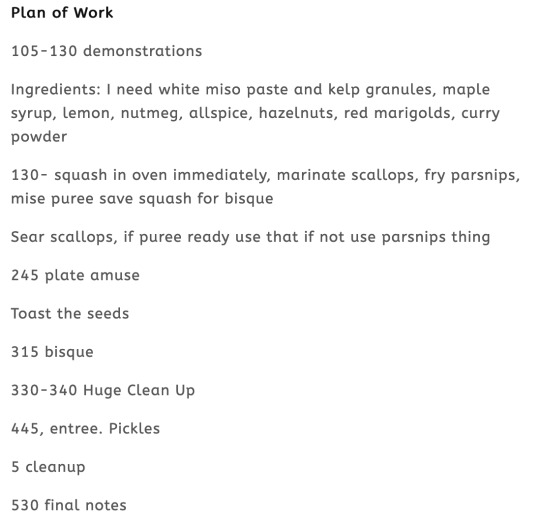
0 notes
Text
Research: Plant Based
Week 4
MENU
Amuse Bouche: Seared King Trumpet Mushrooms, Parsnip & Onion Soubise, Parsnip Crisp Appetizer: Butternut Squash Bisque Entrée: 1. Riced Cauliflower, Caramelized Butternut Squash Steak or 2. Roasted Cauliflower Steak, Butternut Squash Puree, pickles
Part 1 Introductions
Method of cooking/technique to discuss:
Bisque soups, vegetable purees, pickling, advanced sauce - Soubise
Learning Objectives:
Understand the fundamental principles of the cooking a variety of mushrooms.
Produce an advanced vegetable centric entree.
Demonstrate proficiency in preparing an advanced sauce (Soubise)
Prior Knowledge:
Primary Ingredient of the week:
King Trumpet and Lions Mane mushrooms
I wish I knew more about these edible mushrooms. I am interested in fungi, but weirdly enough I have not focused on them as a food. I find them most interesting for their role in the circle of life as decomposers and for their ability to sequester carbon from the atmosphere.
Mushrooms are used for their interesting texture and taste. There are so many kinds and they all have different textures and flavors. Mushrooms can have a lot of umami flavor.
Part 2 Background Information
Method:

Bisque Soups-A bisque soup is meant to be velvety and smooth. The one for this week can be made with all plant based ingredients so I will try to do that. From TheSpruceEats we can learn about the history of bisques.
“Authentic recipes for bisque actually ground the shells of the crustacean into a fine paste, using that to thicken the soup. Nowadays, it is more common to use rice as a thickener. In the more distant past, the word "bisque" encompassed soups made from quail or pigeon, sometimes with chunks of crayfish meat added. However, more recently in the culinary world, it has become quite common to see the word bisque used to describe any puréed soup, whether made from crustacean or vegetable, cream-based or thickened with roux. Butternut squash bisque, tomato bisque, and mushroom bisque are what we will most likely find on restaurant menus.”
Alfaro, D. (2023, January 19). Bisque is more than a thick, creamy soup. The Spruce Eats. https://www.thespruceeats.com/what-is-bisque-995579
Vegetable Purees- Purees are used as a bed under other food items and as flavorful components to recipes. Knowing which vegetables to puree can help ensure a desirable texture. From What's for Dinner?, “Vegetables that are great to puree: sweet potatoes, carrots, beets, parsnips, and cauliflower. Vegetables to avoid pureeing: Fibrous green vegetables like broccoli, and veggies with a shell like peas—they tend to leave strings and pieces that won't puree.”
How to make a vegetable puree: What’s for dinner? What’s for Dinner? (2017, August 15). https://whatsfordinner.com/kitchen-tips/how-to-make-a-vegetable-puree-video/
Pickling- Pickling is a way of extending the usable lifetime of food by creating an inhospitable environment from microbes that would otherwise rot the food. Two ways this is done are through either adding acid such as vinegar or by allowing helpful microbes to prosper and create their own acidic environment to defend from unwanted microbes. The second option, which is known as fermentation, will result in a more complex and nutritional product due to the busywork of the microbes. Microbes are capable of breaking down compounds in the target of fermentation that would otherwise remain intact; this changes the flavor and makes nutrients more available to human digestion.

Image Link:https://soupaddict.com/pickled-sweety-drops/

Umami information center. (n.d.). https://www.umamiinfo.com/richfood/
Soubise- An onion and bechamel sauce. According to Wikipedia "It has many variations, the simplest including just onions, butter, and cream."
Primary Ingredient:
King Trumpet Mushroom- Common Names: King Oyster, King Brown, French Horn

Jenny. (2022, November 7). All about king oyster mushrooms: Growing, cooking, and history. Mushroom Appreciation. https://www.mushroom-appreciation.com/king-oyster-mushrooms.html
From the website Mushroom Council, “King trumpet mushrooms have a delicate, nutty flavor and a firm, meaty texture. When cooked, the king trumpet’s texture mimics seafood, like scallops. In fact, when its thick stem is sliced crosswise, the result can appear just like scallops, too.”
King trumpet mushrooms: Mushroom varieties 101. Mushroom Council. (2023, April 19). https://www.mushroomcouncil.com/mushroom-101/varieties/king-trumpet/

Yore, V. (2020, August 9). Vegan scallops in lemon garlic butter. Wow, It’s Veggie?! https://wowitsveggie.com/vegan-scallops/

Lions Mane Mushroom- Common Names: Lion's Mane, Mountain-Priest Mushroom, Bearded Tooth, Pom Pom Mushrooms
These mushrooms contain significant amounts of vitamins such as thiamine, riboflavin, and niacin, along with minerals such as manganese, zinc, and potassium.

https://www.forbes.com/health/supplements/health-benefits-of-lions-mane/
These mushrooms are delicate and absorptive of water. “Lion’s mane mushrooms offer a mildly sweet flavor and a tender texture that mimics shellfish like scallops, crab, or lobster. For that reason, they are often turned to as an accompaniment or alternative to seafood (Mushroom Council).”
Lion’s mane mushrooms: Mushroom varieties 101. Mushroom Council. (2024, March 14). https://www.mushroomcouncil.com/mushroom-101/varieties/lions-mane/
Part 3 Recipe R&D
Chosen Recipes:
Vegan Seared King Trumpet Mushrooms- Slice the stem into discs, then score the flat ends. Once you have the shape you want the seafood flavor. In a bowl, you are going to want to mix water, white miso paste, soy sauce, salt, and kelp granules. To soften the texture soak for 20 minutes.


Parsnip & Onion Soubise- This recipe has a smoky flavor. I am going to cook the parsnips in the cream. The sweetness comes from softening the onions over a longer time in a pan. The steps are as follows: Burn Scraps, infuse cream with, Cartouche onions in olive oil, add cream strained, boil small cut parsnips and reduce by half, blend, chinois
Parsnip Crisp-slice it and fry it

Parnsip Crisps. The Secret Supper Society. (2021, October 18). https://thesecretsuppersociety.com/dish-recipe/parnsip-crisps/
Butternut Squash Puree- Maple Roasted Butternut Squash Puree: Delicious Dairy-Free Side by Tori Avey Recipe for Dairy Free Maple Roasted Butternut Squash Puree with coconut milk, maple syrup, cinnamon and spices. Vegan, gluten free.

Avey. (2022, April 24). Maple roasted butternut squash puree: Delicious dairy-free side by Tori Avey. https://toriavey.com/maple-butternut-squash-puree/
Amuse Plating: This color scheme but for one scallop

Image Link: https://freddiecipoletti.com/recipes/seared-scallops-with-butternut-squash-and-hazelnuts
Provided Recipes:
Roasted Cauliflower Steak-
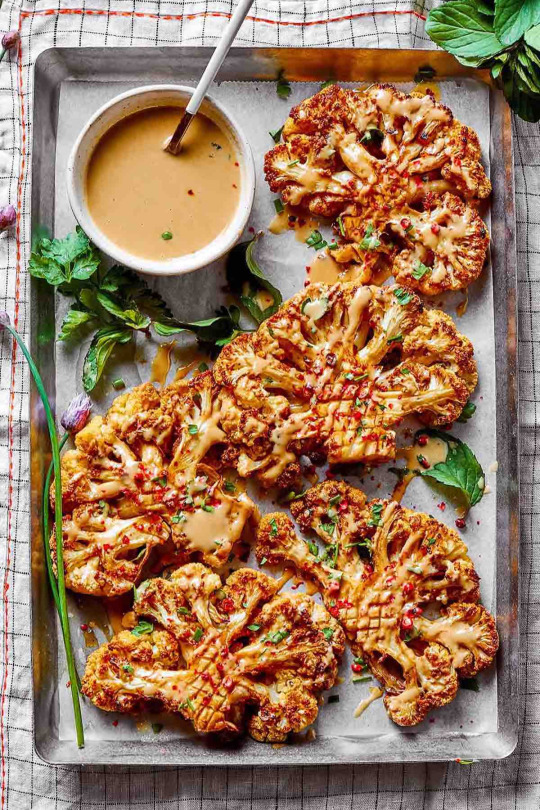

Image Link: https://thebigmansworld.com/cauliflower-steak/ & https://dinnertimesomewhere.com/index.php/dinner/vegetarian-dinner/harissa-roasted-cauliflower-steak/
Butternut Squash Bisque- I am choosing to use the vegan version of our recipe as well as make some modifications including adding curry spices and maple syrup.
Pickles- For our recipe we are using a quick pickling method which involves a brine of vinegar.
Part 4 Recipes
Chosen Recipes:
Seared King Trumpet Mushrooms-
3-5 King Oyster Mushrooms
1 cup water
1 tablespoon white miso paste
1 teaspoon kelp granules [optional if you want seafood flavor]
2 teaspoons soy sauce or tamari
1 teaspoon salt
3 tablespoons vegan butter
2 tablespoons lemon juice
4-5 cloves of garlic, chopped
1/2 cup fresh basil for serving

Parsnip & Onion Soubise- Burn Scraps, infuse cream with, Cartouche onions in olive oil, add cream strained, boil small cut parsnips and reduce by half, blend, chinois
Croft, J. (n.d.). 0:03 / 0:53 Smoked Soubise Sauce LIKE A CHEF . YouTube. https://youtu.be/IpvvbZf1g88
Parsnip Crisp-slice it with peeler and fry it
Butternut Squash Puree-

Tori Avey. (2022, April 24). Maple roasted butternut squash puree: Delicious dairy-free side by Tori Avey. https://toriavey.com/maple-butternut-squash-puree/
Provided Recipes:
Roasted Cauliflower Steak- demonstration in lab
Butternut Squash Bisque-
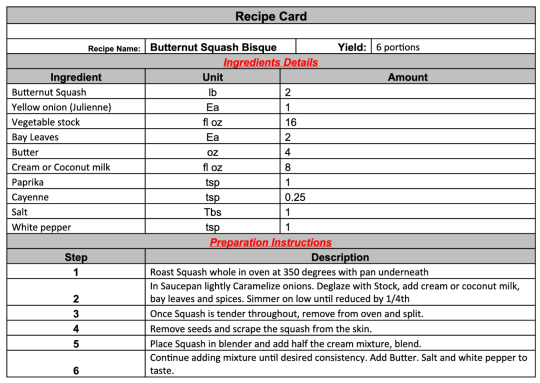
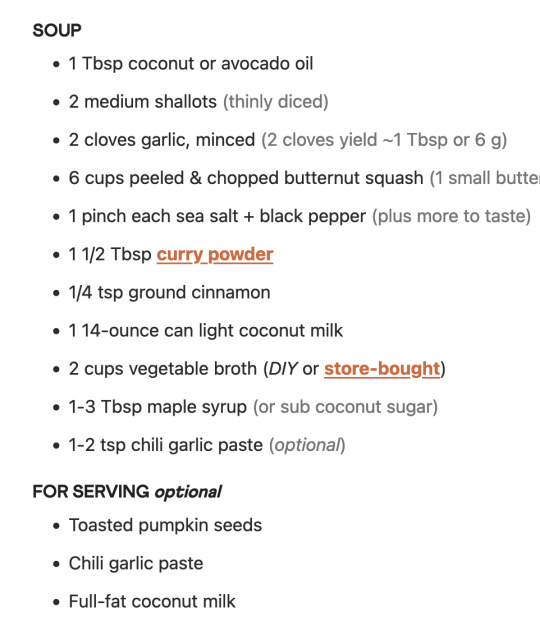
Instructions: make butternut puree and then add this stuff to it and blend again
Pickles-

Plan of Work
105-130 demonstrations
Ingredients: I need white miso paste and kelp granules, maple syrup, lemon, nutmeg, allspice, hazelnuts, red marigolds, curry powder
130- squash in oven immediately, marinate scallops, fry parsnips, mise puree save squash for bisque
Sear scallops, if puree ready use that if not use parsnips thing
245 plate amuse
Toast the seeds
315 bisque
330-340 Huge Clean Up
445, entree. Pickles
5 cleanup
530 final notes
0 notes
Text
Reflection: Pork
Week 3
MENU
Amuse Bouche: Brioche, Lardo, Mostarda Appetizer: Bacon Cooking Experiment (with aioli) Entrée: Braised Pork Cheeks or Braised Pork Belly, Celeriac Puree, Bitter Greens, Warm Bacon Vinaigrette
Part 1 Sensory Results
Amuse Bouche
Taste: lardo was fatty, salty and mild. Bread added sweetness, mostarda sweet and spicy
Flavor: pork flavor, fat flavor not rancid, some herbal flavor, bread flavor, pear and apple, mustard
Texture: crunchy bread, air volume and chew, poached fruit, smooth fat like butter with slightly more resistance
Appearance:


Appetizer (Bacon Experiment)
Taste: pepper maple syrup bacon had sweetness, umami, salt, fattiness and some piquancy.
Flavor: bacon. Some had char, some had maple sweetness. All fragrant of cooked bacon
Texture: ranging from crunchy to chewy and some parts soft and fatty. Sheet pan with parchment had the best texture. Cast iron had a good chewy and crunchy texture but not extremely consistent from the muscle tightening from heat and lifting some segments from contact with the pan so that they cooked less.
Appearance: As you can see the grill had the most different appearance, that dark one that was oven with rack was accidentally burnt.

Entree
Taste: belly-sweet FATTY umami salt; puree- sweet salt; salad-SOUR, BITTER sweet, salt, fatty, umami
Flavor: coriander paprika cumin cayenne, bacon and pig, caramelized sugar, puree had celery and cream flavor with some onion/garlic, greens salad very green and bitter very sour and floral and fruity from pomegranate and champagne vinegar. Balcony, maple from syrup. Spicy from raw greens onion raw
Texture: gooey and crunchy belly, smooth warm puree, crunchy salad croutons, bacon raw greens, greens chewy and zippy vinegar, astringent?
Appearance:
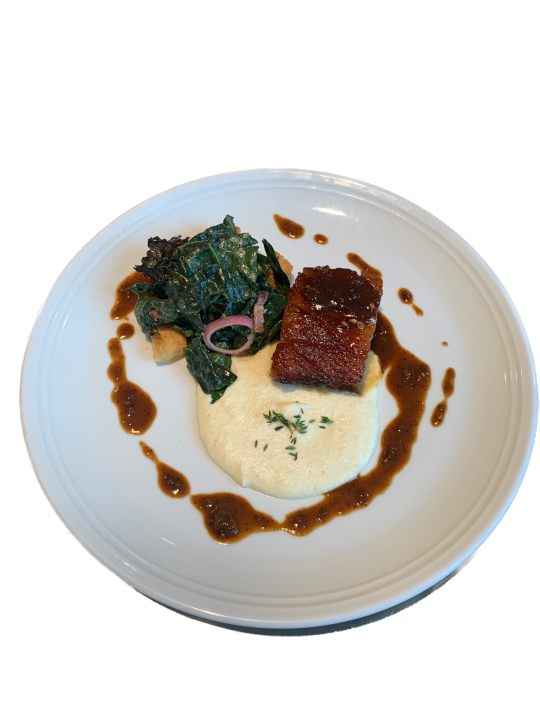


Part 2 Evaluation of Techniques
Technical Outcomes
Techniques that Worked Well
The braising technique for the pork belly worked well. It created a crispy crust and softened meat. It could have cooked longer, but not necessary. Braising worked to soften the meat and melt the fat to blend the flavors from the dry rub and to bring a cooked texture.
The best method for the bacon was the sheet tray with parchment. You can do a lot at once and the product is consistent, hands-off, and good looking. The worst seemed to be the nonstick because of the shape being funky.
The salad method was surprisingly effective. The hot dressing and tearing the leaves apart made it soften but still taste fresh and raw. I would possibly reduce the vinegar to appeal to more people and so that it is not as acidic in the stomach. The fatty belly and acidic dressing in the stomach was kind of intense for me with a sensitive stomach, but I was still fine.
What is braising? how to braise meats and vegetables - 2024. MasterClass. (n.d.-b). https://www.masterclass.com/articles/what-is-braising-how-to-braise-meats-and-vegetables
Picture below of dry rub, rubbed into cuts in the belly slab in preparation of braising.
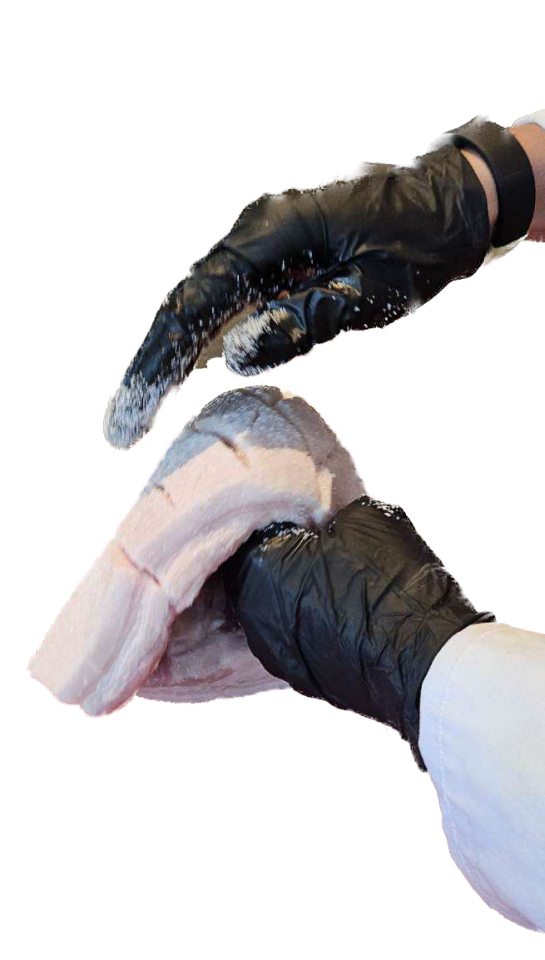
Meyer, J. (2018, July 27). Science of searing: How to Pan Sear Proteins. Hestan Cue. https://hestancue.com/blogs/blog-recipes/the-science-of-searing.
Techniques that Did Not Work Well
The celeriac puree could have been smoother and I would like it to have been thicker, but it was good that it was not leaching water. The aioli was a total flop the first time with the whisking method and had to be redone entirely. The issue was that there was not enough whisking done before the rest of the oil was added. The article below was helpful in understanding the issue.
Dunn, S., & Rahravan, E. (2023, January 5). How to fix a broken sauce . Cook’s Illustrated. https://www.americastestkitchen.com/cooksillustrated/articles/6748-how-to-fix-a-broken-sauce
Torching the lardo surprisingly did not work at all and that idea had to be scrapped. To work around the issue of no color we sprinkled paprika on the lardo.
Assessment of Plate Presentations
There were some presentations that I thought were great for the lardo. The were neat and generous. There is still the trouble of the amuse being too large of a portion so we will see how things go next week. I was not very happy with mine. I think I would have liked to see some ruffling and folding of the lardo rather than every presentation being squares.
Improvements/Changes
In the future I would like to cook the pork belly longer. For the puree and appearance, it should be smoother. I liked my plating this week. I would have liked the plate to be bigger and maybe the salad appear more delicate and to have some flower garnishes, but other than that it was how I wanted it to look from my drawing.
Part 3 Sustainability
This week, we used celery root and site-grown leafy greens from Chef Rivera’s restaurant.
Integration of Practice: The celery root was pureed and it was pleasant to eat and in appearance. The leafy greens were very flavorful and tender. Since they were young and fresh we did not cook them beyond wilting them with the hot bacon vinaigrette. Chef Rivera brought them to our lab from where they were grown at his restaurant.
Impact on Overall Sustainability: As far as the pork belly and bacon, I do not know if we followed sustainable practices. We did not use scraps, however we braised the belly ourselves which is a cost saving measure. We used the root of celery, however celeriac does not seem that cheap; it is between 5 and 10 usd for one when I look online. Maybe if buying from a farmer rather than a secondary source you could buy just the root at a good price. You would have to use a lot of celery in proportion to celery root to use the plants fully since the root produces a lot of celery stalk. Using the scraps from meat is a way to reduce your personal demand for the extremely environmentally taxing production of meat (2000 gallon of water per pound of meat, grain, deforestation, antibiotics, greenhouse gas emissions). If this technique were to be used on a global scale, it would reduce the amount of livestock needed to meet the same demand for meat.
Beef: The “king” of the Big Water Footprints. Water Footprint Calculator. (2023, January 11). https://watercalculator.org/news/articles/beef-king-big-water-footprints/
Personal Performance: I am currently looking into how to get my place of work to start composting. Something good from in the lab is how we all share ingredients with each other instead of breaking into a new one.
Areas for Improvement: A way that we can be more sustainable is to reduce the amount of mess ups we have that waste ingredients. An area for improvement I see for the building is the practice of constantly refrigerating empty refrigerators in the labs. That is a lot of energy and if labs are not being used then the refrigerators should only be on in time for them to be useful in the labs. Of course I am not an engineer so that may not be practical but it's an idea.
Part 4 Conclusions
Outcomes: We cooked bacon, sliced lardo, and prepared a braised pork dish. We also prepared an emulsified sauce and a root puree. We gained knowledge on practical sustainability practices for the restaurant environment.
Objectives: We met the objectives that were to understand the fundamental principles of cooking bacon, produce an advanced braised dish (pork belly or pork cheek), and to demonstrate proficiency in preparing an emulsified Sauce (Aioli), showcasing different consistency and flavor profiles of bacon.
Additional: I learned to consider using more parts of a vegetable such as the root. Celeriac puree is a decent use for the root.
Practice: Work on having drawings and pictures for inspiration so that the final appearance is thoughtful and put together. I am excited to try my ideas next week.
Recipes and Plan of Work
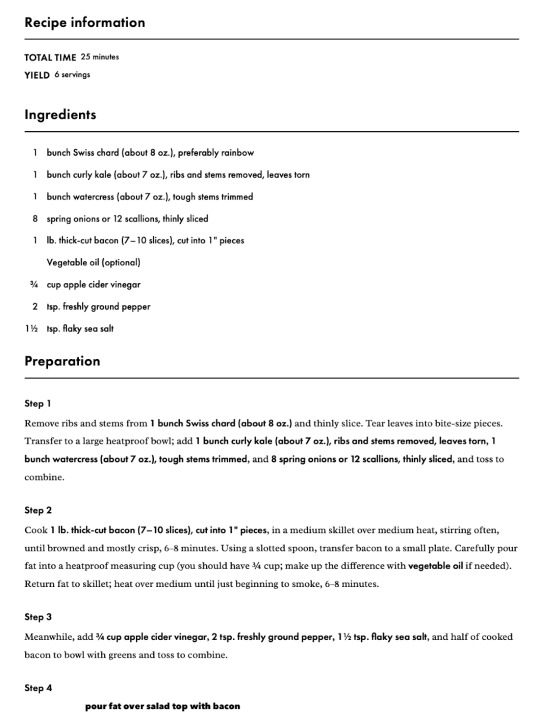

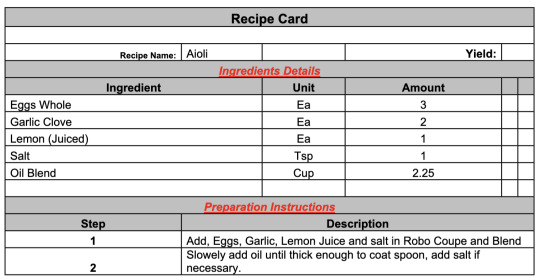


Plan of Work
1-115 discussion
1:15 bellies and cheeks in pastry ovens (half hotel pans for 2-3 hours)
Start mostarda, start aioli for bacon experiment
2:15 bacon experiment
2:35 evaluation of bacon cooking methods
3pm plates up for Amuse Bouche
3:30 cheeks and bellies out of oven, chill then sear
Celeriac puree, bitter greens, warm bacon vinaigrette
4:45 plate up
5pm cleanup
530 debrief
0 notes
Text
Research: Pork
Week 3
MENU
Amuse Bouche: Brioche, Lardo, Mostarda Appetizer: Bacon Cooking Experiment (with aioli) Entrée: Braised Pork Cheeks or Braised Pork Belly, Celeriac Puree, Bitter Greens, Warm Bacon Vinaigrette
Part 1 Introductions
Method of cooking/technique to discuss:
Braising, comparison of bacon cooking methods
Learning Objectives:
Understand the fundamental principles of cooking bacon.
Produce an advanced braised dish (pork belly or pork cheek).
Demonstrate proficiency in preparing an emulsified Sauce (Aioli), showcasing different consistency and flavor profiles of bacon.
Prior Knowledge:
Primary Ingredient of the week:
Braised Pork Cheeks or Braised Pork Belly
Bacon
Lardo
I have had pork cheeks and pork belly at the Korean BBQ. The pork belly is my favorite. I had it smoked with garlic and then grilled on the hot plate. It has a juicier and less salted taste than bacon from the store.
I previously cooked bacon in a frying pan on the stove until I found out about cooking it in the oven. It yields a very consistent product in the oven. I have only cooked it on a tray so that more of the fat drips off, but after seeing the picture in the lesson I may be interested in trying it on parchment. They water also drips off from the rack in the oven method, so on parchment it may be less dried out. I do much prefer it in the oven beyond the convenience of not needing to watch it or get splattered in grease; I think that the fat gets cooked more thoroughly.
Part 2 Background Information
Method:
Braising- According to MasterClass, “Braising is a combination-cooking method that starts with pan searing followed by slow cooking in a liquid—usually in a Dutch oven or a slow cooker—until ingredients become tender. A successful braise transforms both the ingredient being cooked and the cooking liquid itself into something harmonious.” The process is forgiving because it retains moisture and develops flavors easily with time.
What is braising? how to braise meats and vegetables - 2024. MasterClass. (n.d.-b). https://www.masterclass.com/articles/what-is-braising-how-to-braise-meats-and-vegetables
Bacon Cooking Methods- “Bacon is a type of salt-cured pork made from various cuts, typically the belly or less fatty parts of the back.” According to the book excerpt on Canvas, a lot of the flavor comes from the nitrated pink salt used to cure the belly. More of what we think of bacon flavor comes from smoking the bacon. Different wood can give the meat different smoke flavors. We will try cooking the bacon in different ways to see what the results are. These ways include the following:
1. Microwave
2. Sheet Pan with Parchment
3. Sheet Pan with Rack
4. Cast Iron Skillet
5. Flat top
6. Grill
7. Non Stick Pan
8. Non Stick With Water
Wikimedia Foundation. (2024, August 6). Bacon. Wikipedia. https://en.wikipedia.org/wiki/Bacon

Image link: https://www.thekitchn.com/skills-showdown-bacon-22956708
Primary Ingredient:
Lardo- Lardo is the fat from the back of a pig that has been salted/smoked and stored. It is made in two towns in Italy; a small village in the Aosta Valley produces “a fine flavor with a marked aroma of spices” and the village of Colonnata produces “milder and more delicate” lardo.
Lardo is served sliced thinly. According to the producers in Colonnata the lardo should dissolve on your tongue and melt in your mouth. There should be no rancid fat flavor. Lardo beyond being eaten as is can also be incorporated in the cooking of meat such as veal to lend more flavor and richness.
Lardo. La Cucina Italiana. (n.d.). https://www.lacucinaitaliana.com/glossary/lardo?refresh_ce=

Image link: https://www.lacucinaitaliana.com/glossary/lardo
Bacon- As discussed earlier, bacon is made from the fat striated meat of the belly or back of a pig. We will be using it in the vinaigrette/salad as well as trying it with aioli. Bacon has an importance in american cuisine and has for a long time due to its stability at room temperature

Art link: https://lchenart.tumblr.com/post/183394755603/howls-moving-castle-eggs-and-bacon-direct
Braised Pork Cheek/Belly- These follow the method of low and slow heat to soften the meat. Searing high heat before the low moist heat creates umami and flavor that infuses in the long process.

Image link: https://thewoksoflife.com/shanghai-style-braised-pork-belly/
Part 3 Recipe R&D
Chosen Recipes:
Mostarda-Ingredients: Pears, Apples, Cane Sugar, Lemon Juice, Mustard Seeds, Mustard Oil. The mostarda will take about an hour of cooking. The sugar will reduce into a thick mustard syrup that coats the fruit.
Bitter Greens- “Cook bitter greens with bacon or sausage, pump up the garlic, throw in something spicy, or add a sweet element, like roasted squash or dried fruit. Having a strong contrasting flavor will temper the bitterness and help balance the dish out since bitter greens can have a strong vegetal flavor in addition to bitterness.”
Gallary, C. (2019, May 2). 5 ways to tame bitter Greens. Kitchn. https://www.thekitchn.com/5-ways-to-tame-bitter-greens-214850
Warm Bacon Vinaigrette- I found a recipe that pours hot fat over a salad with the bacon vinaigrette on it. I think it will be interesting to see how the popping fat tames the bitter greens.

Provided Recipes:
Braised Pork Cheek- The pork is seared to have the Maillard reaction and gain flavor, then it is cooked for 2-3 hours to soften and cook the meat as well as render the fat. The juices coming off are strained and made into a sauce with some added butter. Rest, slice, sear and serve.
Aioli-The aioli relies on properties that the garlic and egg yolk have as well as the power of shearing from the robot coupe. Garlic and egg yolk both have enzymes that help to form an emulsion of oil and water. Whisking splits the oil into small drops that can be suspended in water.
Celeriac Puree- The celery root is boiled and then blended. This recipe says the root can be mashed or riced which I might try instead.

Part 4 Recipes
Chosen Recipes:
Mostarda

Bitter Greens and Warm Bacon Vinaigrette
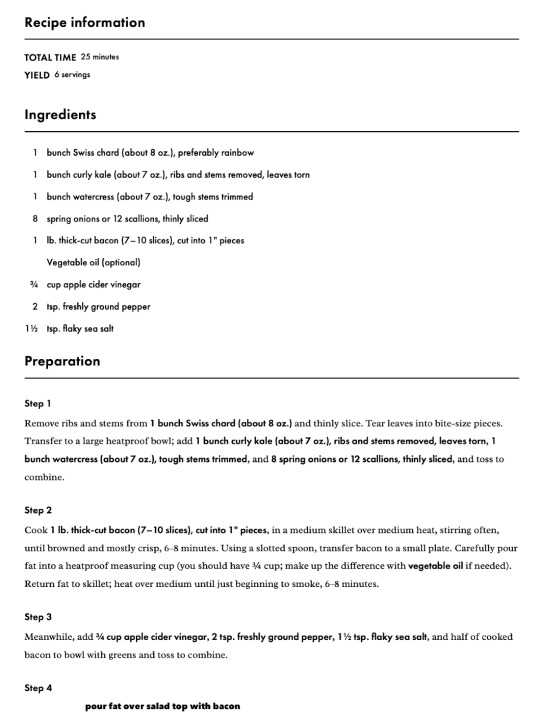
Milton, T. (2023, March 14). Spring greens with hot bacon vinaigrette. Bon Appétit. https://www.bonappetit.com/recipe/spring-greens-with-hot-bacon-vinaigrette
Braised Pork Belly

Image link:
https://thewoksoflife.com/shanghai-style-braised-pork-belly/
Provided Recipes:
Braised Pork Cheek

Aioli

Pork Belly Rub

Celeriac Puree (Celery Root)

Plan of Work
1-115 discussion
1:15 bellies and cheeks in pastry ovens (half hotel pans for 2-3 hours)
Start mostarda, start aioli for bacon experiment
2:15 bacon experiment
2:35 evaluation of bacon cooking methods
3pm plates up for Amuse Bouche
3:30 cheeks and bellies out of oven, chill then sear
Celeriac puree, bitter greens, warm bacon vinaigrette
4:45 plate up
5pm cleanup
530 debrief
0 notes
Text
Reflection: Steak Butchery
Week 2
MENU
Amuse Bouche: Steak Tartare Appetizer: Meatballs Entrée: Steak dishes - 1. Beef (Filet Mignon) or 2. Veal (Rack), Vegetables, Potato, Sauces: Compound Butter, Bearnaise, Au Poivre
Part 1 Sensory Results
Tartare
Taste- metallic, tangy, mild in taste, distinctly lacking in umami due to the meat being raw, sour and salty bites from pickles,
Flavor- shallot, capers, mustard. Not much meatiness. Mild flavor
Texture- squishy, chewy, different crunchy textures from the whole grain mustard, shallots and cornichons, leaner mouthfeel depending on the egg yolk integration. Crunchy bread complemented the squishiness
Appearance:

Veal and Asparagus
Taste- umami, salty, bitter here and there, spicy peppercorns, fat
Flavor- peppercorns, grilled meat, butter, white wine, toastiness, bloody
Texture- tender meat, pop and crunch of peppercorn with unfolding of pepper taste, creamy sauce. Medium level of definition to the protein fibers, somewhat lean
Appearance:

German Potato Salad
Taste: Sour, starch, salt
Flavor: vinegar, mustard seed, earthy potato, oil
Texture: soft buttery smooth potato. Excellent texture on the potatoes. Room temperature. Oil and vinegar smack on the lips
Appearance:

Part 2 Evaluation of Techniques
Technical Outcomes:
Techniques that Worked Well- The searing technique worked well for the veal rack. Originally we were going to bread the veal and then pan fry but we switched to no breading. I seared my steak on the gas grill. The size of my piece was big enough compared to the intensity of the grill so that I could sear it twice on each side and not overcook the center. “The Maillard reaction is an interaction between amino acids and reducing sugars that browns food and gives it that roasty, toasty flavor. This process is essential to cooking, not only because it lends color, but because it creates hundreds of ester molecules that give rise to an array of aromas and flavors.”
Meyer, J. (2018, July 27). Science of searing: How to Pan Sear Proteins. Hestan Cue. https://hestancue.com/blogs/blog-recipes/the-science-of-searing.
Techniques that Did Not Work Well- The Bearnaise sauce recipe did not turn out quite right at first due to the sauce being too hot when I added the butter. Something that I discovered when trying to fix the split sauce was that adding a small bit of solid butter and whisking brought the sauce back together with amazing results. The sauce came right back to emulsion and was still warm. Based on this Cooks Illustrated article, I believe that the reason my sauce broke is that too much of the water evaporated. They found that the oil floats to the top and puddles because the fat droplets do not have enough water to hold them in suspension.
Dunn, S., & Rahravan, E. (2023, January 5). How to fix a broken sauce . Cook’s Illustrated. https://www.americastestkitchen.com/cooksillustrated/articles/6748-how-to-fix-a-broken-sauce
Assessment of Plate Presentations
There were some presentations that I enjoyed and there were some that were overly elaborate in the decoration or had a few thoughtless choices. For instance, the use of multiple spoon pushes on the plate seemed overdone for a huge steak dinner. The stacking of the carbs under or over the protein also seemed overly elaborate. The one with the broccolini propping up the steak was interesting but I did not like that the broccolini was presented also as a decoration on the plate in front of the steak for the reason that it acts like something new and scarce and delicious but really there is plenty more under the steak. The purple mashed potatoes looked alien and fun. I like that the plates had yellow, orange, red, green and brown and sometimes purple.
Improvements/Changes
In the future I would choose to have the bone of the veal curving up instead of in a rainbow shape to the plate. It was still easy to eat but I think it would look more stable and hearty with the meat laying on the plate and the bone flying into the air. I love how the peppercorn sauce looked. Sadly the asparagus seemed like an afterthought on the plate and should have been trimmed shorter. It was too uniform all facing the same way. It should be more jumbled and overlapping to not only provide volume but to convey the sense that it was artistically dropped from a tiny airplane.
Part 3 Sustainability
This week, we trimmed meat in house instead of buying trimmed meat.

Integration of Practice- In our lab we used the scrap pieces from the steak tenderloin that were not the perfect filet steaks or spinalis by turning them into meatballs and tartare. Something that my group did outside of the instruction is we used leftovers of the leftover meat to impart steak flavor into the au poivre sauce. We were not searing our steaks in a skillet so we found a way to have the flavor and we helped to have less of the meat go straight to waste.
Impact on Overall Sustainability- Trading a higher labor cost for a lesser product cost in this instance is a way to save money. In addition to that, the scraps can be used and do not need to be purchased separately. As far as sustainability, using the scraps is a way to reduce your personal demand for the extremely environmentally taxing production of meat (water, grain, deforestation, antibiotics, greenhouse gas emissions). If this technique were to be used on a global scale, it would reduce the amount of livestock needed to meet the same demand for meat.
Personal Performance- I am currently looking into how to get my place of work to start composting. Something good from in the lab is how we all share ingredients with each other instead of breaking into a new one.
Areas for Improvement- Within the lab, I messed up with the peppercorns and ground them too small so I had to start again. Instead of tossing out the toasted ground pepper I should have saved it. I was not thinking about sustainability in that moment and I made a mistake. A way that we can be more sustainable is to reduce the amount of mess ups we have that waste ingredients. An area for improvement I see for the building is the practice of constantly refrigerating empty refrigerators in the labs. That is a lot of energy and if labs are not being used then the refrigerators should only be on in time for them to be useful in the labs. Of course I am not an engineer so that may not be practical but it's an idea.
Part 4 Conclusions
Outcomes
We prepared beef tenderloin steaks and veal as well as produced a variety of advanced sauces. We gained knowledge on practical sustainability practices for the restaurant environment.
Objectives-We met the objectives that were to compare and contrast different dry heat methods for cooking beef tenderloin steaks and veal and to produce a variety of advanced sauces - compound butter, bearnaise, and pan sauce.
Additional
I learned to be sure to grease a grill before placing your meat.
Practice- Work on having a clearer picture of the dishes to be made so that work is more fluid and the instructions may be consulted less.
0 notes
Text
Research: Steak Butchery
Week 2
MENU
Amuse Bouche: Steak Tartare Appetizer: Meatballs Entrée: Steak dishes - 1. Beef (Filet Mignon) or 2. Veal (Rack), Vegetables, Potato, Sauces: Compound Butter, Bearnaise, Au Poivre
Part 1 Introductions
Method of cooking/technique to discuss:
Sear Vs Char Grill
Tartare
Learning Objectives:
Compare and contrast different dry heat methods for cooking beef tenderloin steaks and veal
Produce a variety of advanced sauces - compound butter, bearnaise, and pan sauce
Prior Knowledge:
Primary Ingredient of the week:
Veal, in particular Veal Rack
Beef Tenderloin
I have cut some beef tenderloin before, but I need more experience before I would be willing to hack into one myself unsupervised. The filet mignon is the round cut at the softer end of the tenderloin.
When I worked as a garde manger at Acre I made a lot of steak tartare. Their dish uses the scrap from the steaks, it has the yolk mixed in, and it is topped with fried capers and thinly sliced radishes. The black round bowl is frozen with a smear of blue cheese sauce on about a third of the rim and the tartare is shaped inside a ring. The rest of the recipe is pretty similar to the one provided.
Veal is something I have not prepared before. Veal is usually the meat from a young male dairy cow (no good for dairy). I am familiar with breading and pan frying. Veal is very $$$$
Part 2 Background Information
Method:
The USDA recommends cooking whole muscle veal cuts like veal steaks, roasts and chops to 145 degrees F (medium rare), 160 degrees F (medium), or 170 degrees F (well done). Since this meat is so expensive, compromising on ingredients or making a mistake in the cooking process is a bad idea. Tenderizing the meat with a mallet and removing stringy connective tissue will make the veal softer in texture.
Searing- “The Maillard reaction is an interaction between amino acids and reducing sugars that browns food and gives it that roasty, toasty flavor. This process is essential to cooking, not only because it lends color, but because it creates hundreds of ester molecules that give rise to an array of aromas and flavors.”
Meyer, J. (2018, July 27). Science of searing: How to Pan Sear Proteins. Hestan Cue. https://hestancue.com/blogs/blog-recipes/the-science-of-searing.
Char Grilling- The difference between searing and grilling is that searing is direct heat while grilling is indirect. Char grilling is where the heated metal chars or burns the outside of the food leaving dark lines from the contact points with the grill surface.
Primary Ingredient:
Filet Mignon is often the most tender and lean cut. It is also pretty expensive because it is in a limited quantity on the cow. Filet mignon often has a milder flavor than other cuts of meat and as such is often garnished with a sauce like we are doing in our lab with the Bearnaise or Au Poivre.

https://www.angus.org/pub/beefchart.pdf
Veal is the meat from young cows, 3 to 14 weeks old. The meat is lean and has a bit of white fat on the outside. It is desirable for it to have a gray color. To do this, the farmers will sometimes deprive the animals of their natural sources of iron to give the meat a gray color. In Europe, it is cooked rare while in the US it is cooked more fully. The veal cutlet can be pan fried with breadcrumbs to make a veal schnitzel.

https://www.britannica.com/topic/veal
Part 3 Recipe R&D
Chosen Recipes:
Panko Breaded Veal Rack- This recipe I intend to mostly follow. It is “Chef Thomas Keller’s Wiener Schnitzel Recipe” found on the website Masterclass. The recipe asks for veal top round which I do not have, however I watched a video demonstration of someone pan frying some veal rack; he just tenderized it with a mallet to get it to a lesser thickness. As long as we remove the sinew and connective tissue it should be tender. I chose it of course because the chef is a famously good chef and the recipe seemed easy to follow with the resources available.
Chef Thomas Keller’s Wiener Schnitzel Recipe - 2024. MasterClass. (n.d.). https://www.masterclass.com/articles/chef-thomas-kellers-wiener-schnitzel-recipe#2snWmni7k0EQ40Ue0QgGWS
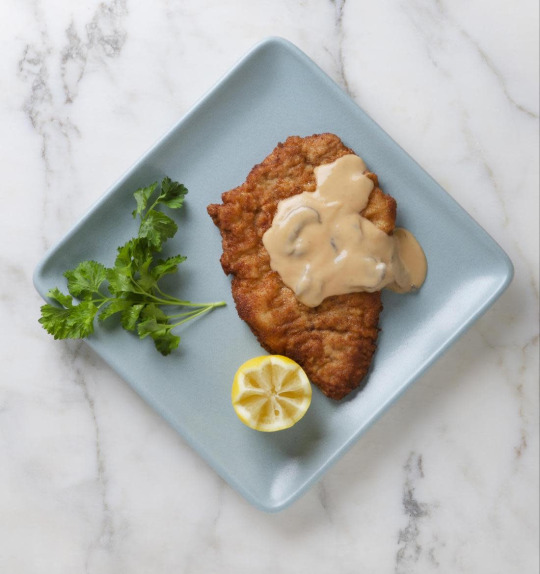
https://www.masterclass.com/articles/chef-thomas-kellers-wiener-schnitzel-recipe#2snWmni7k0EQ40Ue0QgGWS
Vegetables- Roasted Asparagus and German Potato Salad- Well the asparagus will go great with the bearnaise and we would love to get some char flavor on it since there will not be that same flavor in the breaded veal. The potato salad was linked with the veal schnitzel recipe and since they are both German recipes and suggested to be together.
Compound Butter- Take some softened good quality butter, chop some herbs, roll them together into a log that can then be sliced. I got the flavor combinations from the blog Love and Lemons. I chose it because the photography was elegant and looked modern.

Provided Recipes:
Steak Tartare- The instructions say to get the meat colder so it's easier to cut. From there it is blending up some punchy flavors like shallot and mustard as well as some umami. The fat comes from the egg yolk on top and I guess most people know they should mix it in for the best effect. Capers add a burst of salty and sour for a nice surprise. Personally I would like the texture to be dippable on the bread so I would prefer the dice to be tiny, maybe a knife to spread it.

https://www.wineenthusiast.com/recipe/make-beef-tartare-home-recipe/
Meatballs- Chef Eric Rivera’s personal recipe that he loves. No intended modifications. I see that the meat and the bread crumbs do not get blended together and that they are instead combined by hand probably for a less homogenous texture.
Au Poivre- This is a French sauce not super common in the US but popular in Europe. The sauce is made in the pan after searing the steak so you can deglaze the meat browning and flavors. DAMN that looks tasty

https://www.sipandfeast.com/steak-au-poivre/
Bearnaise- The recipe involves egg yolks which have a thickening power, however they are temperamental and will curdle if too hot, and loosen if not heated up to 185F due to the enzymes that break it down still being active up to that temp. This temp thankfully coincides with the nappe texture for the most part so you do not need a thermometer. Good on top of meat and in our case asparagus.
Part 4 Recipes
Provided Recipes:
Au Poivre

Bearnaise Sauce

Meatballs

Steak Tartare

Recipes Researched
Breaded Veal- Chef Thomas Keller’s Wiener Schnitzel Recipe

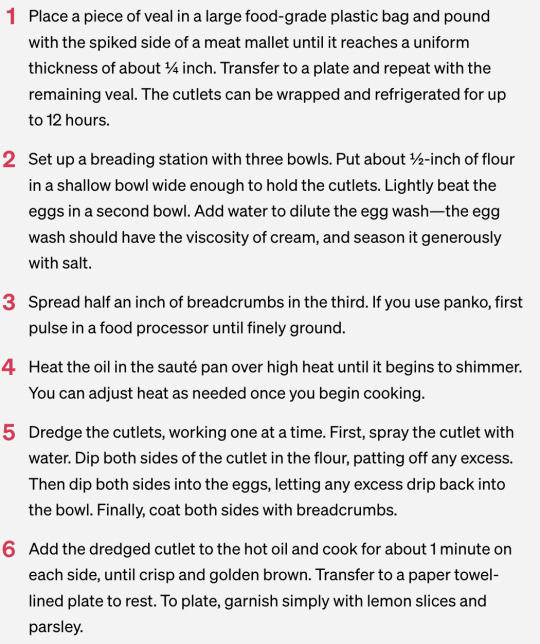
Vegetables- grilled asparagus Potatoes- Chef Thomas Keller’s Recipe for German Potato Salad


Compound Butter-

https://www.loveandlemons.com/herb-compound-butter/
Plan of Work
Start 1pm, demos until 1:20-1:30, no ingredients requests after 2 Get the butter to room temp Trim the meats, need for meatballs and tartare Watch meatball demo, work tartare all the way Boil the taters Mix dressing for the taters and finish that salad let sit room temp, Meanwhile compound butter Au poivre can work any time, keep warm and reduce Set up dredging station for veal Boil water for double boiler (bearnaise) Finals steps: Fry veal, grill asparagus, bearnaise
Plate up at 5. discussion and out by 5:50
0 notes